South Korea has a rich heritage of traditional arts and crafts, and one area where this is particularly evident is in their sewing techniques. From traditional hanboks to contemporary fashion, Korean sewing techniques have been carefully handed down through generations, resulting in detailed and exquisite garments. This article explores some of the unique and fascinating sewing techniques that make Korean fashion so captivating.
Hanbok Sewing Techniques
The hanbok is the traditional Korean attire, characterized by its vibrant colors, graceful lines, and intricate designs. The construction of a hanbok involves various sewing techniques that have been refined over centuries. One of the most notable techniques is called ‘ottchim.’ It refers to meticulously attaching fabrics together without using any visible stitches. The seams are meticulously hidden within the layers of the garment, creating a clean and seamless finish. This technique requires precision and skill, making each hanbok a work of art.
Another significant sewing technique used in hanbok is called ‘gores.’ It involves sewing triangular-shaped fabric pieces together to create voluminous skirts or sleeves. The precise measurement and alignment of these triangular pieces are crucial to achieving the desired flow and silhouette of the hanbok. The gores technique adds a three-dimensional aspect to the garment, bringing it to life when worn.
Bojagi Sewing Techniques
Bojagi is a traditional Korean wrapping cloth traditionally used to wrap and carry items. These vibrant and colorful fabric pieces are made using a patchwork technique called ‘jogakbo.’ Jogakbo involves piecing together scraps of fabric, often in different shapes and sizes, to create a larger cloth. The edges of each fabric piece are meticulously folded and sewn with tiny stitches, creating beautiful and intricate patterns. The bojagi sewing techniques not only provide strength and durability to the fabric but also result in visually stunning and versatile textile pieces.
Contemporary
While traditional techniques continue to be treasured and preserved, contemporary Korean fashion also embraces innovative sewing techniques. Today, Korean designers are experimenting with various fabrics, textures, and silhouettes, giving rise to a fusion of traditional and modern aesthetics.
One popular contemporary sewing technique in Korean fashion is the use of pleats. Pleating fabrics add volume, texture, and movement to garments. Korean designers have perfected the art of creating delicate and refined pleats, often using materials like silk or chiffon to achieve a graceful drape and flow.
Another prevalent technique is the manipulation of fabric through intricate folding and tucking, often referred to as ‘origami fashion.’ By skillfully folding and stitching textiles, Korean designers can create unique shapes and structures, resulting in visually captivating garments that push the boundaries of traditional sewing techniques.
Conclusion
Korean sewing techniques are an integral part of the country’s artistic heritage. Whether it be the meticulous construction and hidden stitches in hanboks, the patchwork masterpieces of bojagi, or the innovative techniques seen in contemporary fashion, Korean sewing techniques showcase the immense skill, creativity, and attention to detail of Korean artisans. These techniques continue to captivate the world and inspire the next generation of designers, ensuring the legacy of Korean fashion lives on.




